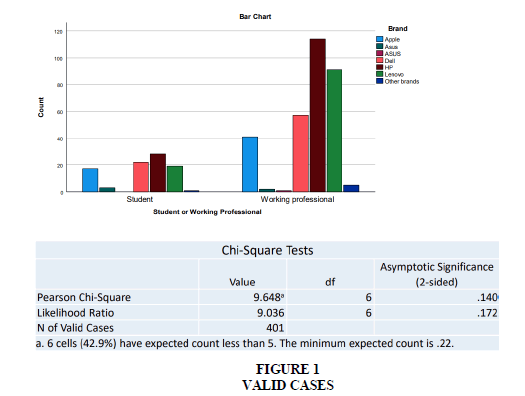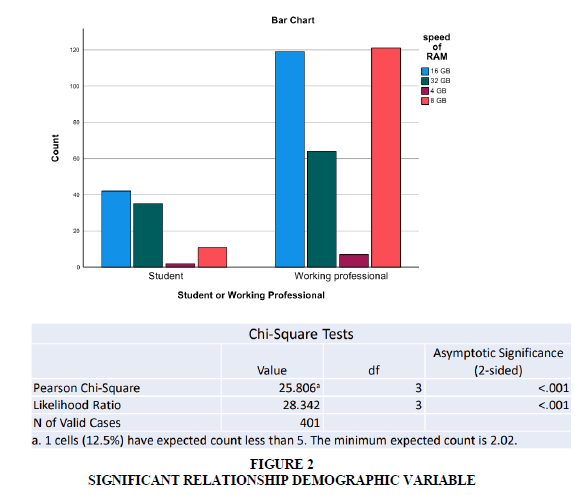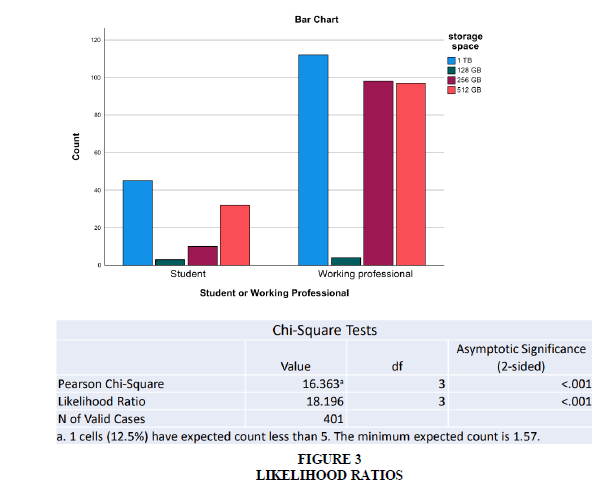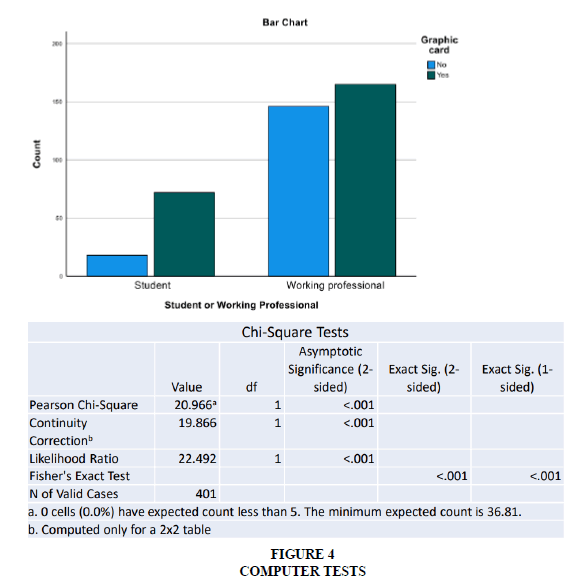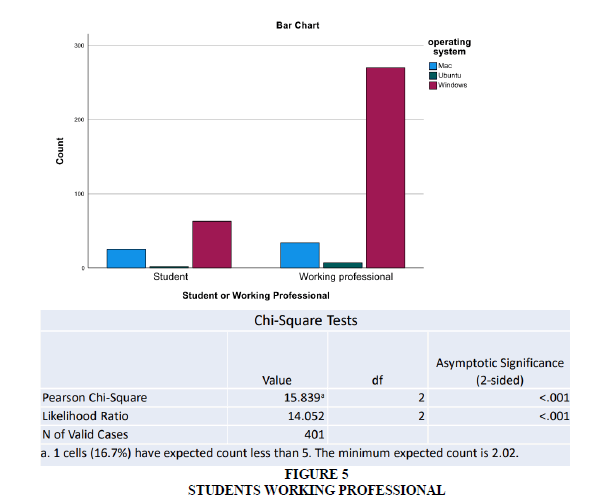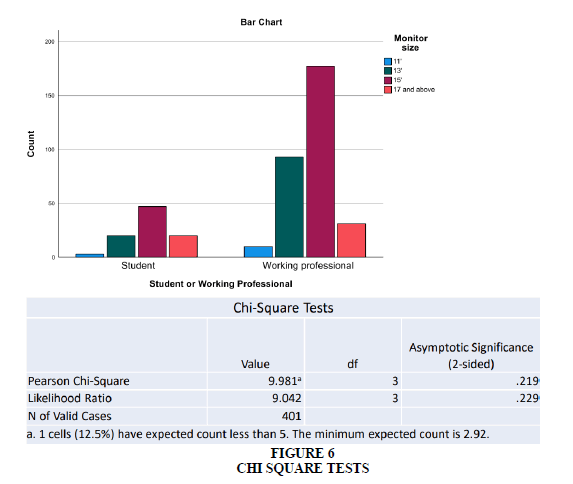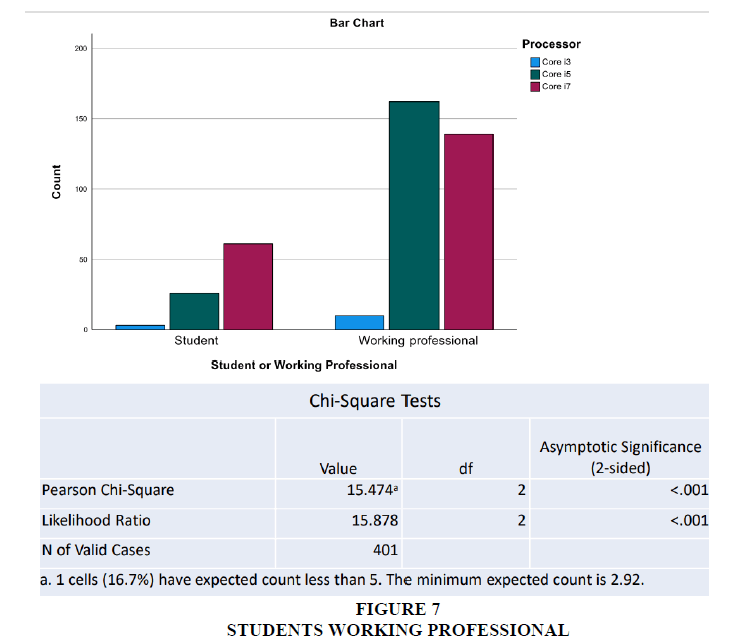Research Article: 2022 Vol: 26 Issue: 4S
Understanding Customer Preferences on Laptop Variants and Models for Students and Working Professionals
Ramya K Prasad, Loyola Institute of Business Administration
Shanti Venkatesh, Loyola Institute of Business Administration
Citation Information: Prasad, R.K., & Venkatesh, S. (2022). Understanding customer preferences on laptop variants and models for students and working professionals. Academy of Marketing Studies Journal, 26(S4),1-12.
Abstract
Purpose of the study: Computers have become inevitable for small businesses, as well as in the home front, irrespective of their size, shape, model- variants and their cost. Pandemic also has mandated people to purchase one gadget or the other to meet the challenges of work-from home / online education. The researchers aimed to study the Customer demographic profile & purchase behaviour of buying laptops among the IT, manufacturing industry and educational sector (students) laptop users. The study also aims to determine the competitive intensity and attractiveness of this sector. Methodology: To study the Customer demographic profile & purchase behavior of buying laptops among the IT, manufacturing industry and educational sector (students), the researchers have undertaken a quantitative research study using probability sampling method. The data is collected from a sample of 400 students and working professionals in Tamil Nadu, India, using simple random sampling technique. Structured questionnaire has been used for collecting primary data. Main Findings: This research seeks to develop a better understanding of the customer demographic profile & purchase behaviour of buying laptops among the IT, Manufacturing industry and student users. The study also indicates the factors influencing consumers’ laptop purchases. All working professionals and students have the similar preferences in Brands of laptop and the size of the monitor, whereas purchase behaviour of customers differ, when it comes to price, speed, storage, graphic card, operating system and processor. Application of the study: Although the survey in this paper is illustrated in respect to the perspective of working professionals and student laptop users, it can be interesting to replicate the study on student laptop-users of different cities and countries and compare the obtained results in a future work. Similar studies on other techno-gadgets such as tablets or smart phones can be carried out to understand the market trends and changing customers’ needs and wants and evaluate their demographic profile & purchase behaviour. Novelty / Originality of the study: The study on the customer demographic profile & purchase behaviour of buying laptops among the IT, manufacturing industry and educational sector (students) laptop users is an original piece of work by the researchers. However, the topic may be common and a number of studies in this area have been conducted earlier too. The study would help to understand the market trends and changing customers’ needs and wants and evaluate their demographic profile & purchase behaviour of laptops considering factors such as brands, price, speed, storage, graphic card, operating system and processor. Such studies provide valuable base data for the laptop manufacturers and marketers to re-design their product and services, according to needs and wants of their customers.
Keywords
Buying of Laptops, Laptop Brands, Monitor Size, Graphic Card, Operating System, Processor of the Laptop, Laptop Prices And Offers.
Introduction
Computers are getting more compact, cuter and weightless, becoming faster with advancements in chip technologies and more powerful in their capabilities. Computer hardware professionals are constantly experimenting, designing, and building smaller, stronger microchips and microcomputers to meet the growing demand of businesses and consumers Aksut et al. (2022). Computers are now part of many consumer appliances, toys, and vehicles, and are available in popular forms such as laptops and tablets. Handheld computing devices, such as the iPhone and Android, have become widespread and are increasingly popular computing platforms. Their success has prompted computer companies to invest heavily in their design and development departments to produce the next high-tech item. The computer hardware industry also includes the manufacturing of peripherals such as modems, monitors, scanners, and just about anything that can be attached to a computer. The popularity of computers, whether used for business, school, or personal entertainment, remains strong and continues to grow. This success hinges, in part, on the work of the computer hardware field where talented and driven individuals are needed to design, build, analyse, and serve the market to keep themselves abreast and develop an edge over the competitors Jyotidiwy et al. (2022).
Objective
To study the Customer demographic profile & purchase behavior of buying laptops among the IT, Manufacturing and Educational industry laptop users.
Sub-Objectives
1. To determine primary usage pattern of laptop in various industries
2. To understand customers’ specific and advanced requirements for IT, Manufacturing and Educational industry users
3. To study the demographic profile of laptop buyers.
4. To understand factors influencing laptop purchase decision.
5. To establish critical factors for customers dissatisfaction in their choice of laptops.
Hypothesis
There is no significant relationship difference between the customer demographic profile & purchase behaviour of buying laptops among students and working professionals.
Scope of the Study
The study mainly focuses on primary usage of laptop in various industries and to understand customers’ specific and advanced requirements for IT, Manufacturing and Educational industry users. In specific, the study focuses on demographic profile of laptop buyers, factors influencing laptop purchase decision & critical factors for customers dissatisfaction.
Limitations of the Study
The following were the limitations that are encountered by the researchers during the period of the research work and affected the research process. The sample size was 400 consumers from Chennai only and the survey was conducted virtually due to the pandemic situation and most responses were received. Some of the respondents had given casual and incorrect data and hence such responses could not be included in the study (Muthuprasad et al., 2021). The study is subject to researchers’ understanding and a lot of commercial information was available in place of research-based information leaving the researchers to experience dearth of particular review of literature.
Review of Literature
According to (Kay & Lauricella, 2011) in the article titled Exploring the Benefits and challenged of using Laptop computers in Higher education Classroom in the Canadian Journal of Learning and Technology, said “Because of decreased prices, increased convenience, and wireless access, an increasing number of college and university students are using laptop computers in their classrooms. This recent trend has forced instructors to address the educational consequences of using these mobile devices”. In their article on Identifying the problems of laptop users and related health problems in the International Journal of Medical Science and Public Health 3(1):1 have stated that “Spending a lot of time in front of laptop may contribute to the awkward body posture which will lead to other ergonomic issues. This condition was also seen among medical students where prolonged awkward body posture has created various musculoskeletal problems”.
(Alassaf et al., 2013), in their article SWOT analysis-of King Abdullah II School for Information Technology at University of Jordan, in the International-Journal-of-Advanced-Corporate-Learning-iJAC-1867-5565 has stated that “SWOT analysis technique can be evaluated on the company level and on the product level to understand the current level of the business. This helps the business to decide on the next step of the company decisions”.
In the Journal of Marketing, Vol. 80, No. 6, AMA and MSI Special Issue of "Journal of Marketing" | Mapping the Boundaries of Marketing: What Needs to Be Known (November 2016), pp. 69-96 (28 pages), Published by: Sage publications Inc on behalf of American Marketing Association, have mentioned that “Customers now interact with firms through myriad touch points in multiple channels and media, and customer experiences are more social in nature. These changes require firms to integrate multiple business functions, and even external partners, in creating and delivering positive customer experiences. In this article, the authors aim to develop a stronger understanding of customer experience and the customer journey in this era of increasingly complex customer behavior”.
Aslihan et al. (2006) University, Istanbul, Turkey (January 2006) in a paper on factors influencing consumers’ Laptop purchases published in Researchgate through the GCBE Conference at USA Volume: 6th, has mentioned that “Consumers can prefer certain products, brands or companies over others, and to understand the reason behind these choices is exceptionally essential in order to market existing products more effectively than rivals”.
(Behzadian et al., 2011) in their article titled ‘Iranian Students’ Preferences for Laptop: a Conjoint Analysis’, published in European Journal of Economics, Finance and Administrative Sciences ISSN 1450-2275 Issue 39 (2011) and in Researchgate https://www.researchgate.net/publication/288456940, have mentioned that “Students are one of the huge populations of laptop consumers and companies need to consider their preferences in their products. The aim of this study is to examine Iranian students’ preferences for laptop using a conjoint analysis known as traditional full-profile conjoint analysis. Results indicate that the four most important determinants of laptop preferences were price, size, processor speed and graphic card which have significance for managers developing marketing strategies and programs”.
Cliff (2021) talking about the Post Covid Workstation Strategy in ‘https://www.computerweekly.com/blog/Cliff-Sarans-Enterprise-blog/A-desktop-strategy-for-post-pandemic-return-to-work’, said that “People do not feel compelled to return to the office. At the very least, they have no plans to work in an office full-time. Hybrid work, where people are given the freedom to work from home, will mean office space will have to be reconfigured. Dedicated desk space or hot desking? Laptop or desktop? Mac or Windows? At the end of the day, people require a device to access corporate applications. The employee experience needs to be the same, whether access is from home or the office”.
Published a paper on Students’ perception and preference for online education in India during COVID -19 pandemic, in the Social Sciences and Humanities Open, now available on https://papers.ssrn.com/sol3/papers.cfm?abstract_id=3596056, has mentioned that “most educational institutes have shifted to online learning platforms to keep the academic activities going. In India, where the technical constraints like suitability of devices and bandwidth availability poses a serious challenge. The results indicated that majority of the respondents (70%) are ready to opt for online classes to manage the curriculum during this pandemic”.
(Prasad, 2020) in an article ‘PC makers expect surge in demand for laptops post lockdown’, published in the MINT (https://www.livemint.com/technology/tech-news/pc-makers-expect-surge-in-demand-for-laptops-post-lockdowns-11587904104192.html) has mentioned that “PC makers expect demand for laptops to rise even after the covid-19 lockdowns are lifted as they anticipate the work-from-home culture to last for at least a short term. Besides, the companies will now focus more on the online channels, since offline retail will take time to return to normalcy”.
Tech Writer, a tech-enthusiasts who likes to fiddle with latest gadgets and tech happenings around the world, in his blog and facebook page has mentioned that “Flipkart witnessed a 200% hike in laptop demands post-lockdown- Since the global pandemic strikes, schools and offices switched to online platforms. As a reflection, demands for tabs and laptops are increased for the past several months and still increasing, however, there are other electronics items too such as truly wireless earphones, Bluetooth neckbands, smartphones, and more”.
Methodology
Simple Random Sampling with only primary data has been used for the study. Primary data is collected with the help of a structured questionnaire. A sample of 401 individuals in Tamil Nadu region was selected using simple random sampling method. The time period for the primary data collection was December 2021 to January 2022. Chi-square test is used for testing the association between demographic variables and the purchase pattern of customers. Each demographic variable has been tested for association individually with the dependent variable and results of each test has been mentioned in detail. 40 samples were collected with the set of 13 questions were used for the pilot survey to understand the customers expectation. A google form was created with these questions. The Pilot survey questions were shared with few customers from different industries and their feedback was consolidated and the analysis were done based on the same Duran & Woodhams (2022).
Data Analysis
As a result of Sample collection from various working professionals & students, researchers have analyzed the data as follows,
If you are a working professional, what industry do you belong to?
311 responses
Analysis Using SPSS
Nonparametric chi-square test of independence/association is used for testing the association between demographic variables and the purchase pattern of customers. Each demographic variable has been tested for association individually with the dependent variable and results of each test has been mentioned in detail.
1. Sub hypothesis testing, we are considering the demographic variable “Category” (Student vs Working professional) and Brand of laptop Figure 1.
As we can infer from the above output table the Pearson Chi-Square is 9.648
The Asymptotic Significance is 0.140 which is greater than the alpha value of 0.05. Therefore, the null hypothesis should be accepted. There is no significant relationship between the demographic variable “Category”(Student vs Working professional) and Brand of laptop Figure 2.
2. Sub hypothesis testing - we are considering the demographic variable “Category”(Student vs Working professional and Speed of RAM of laptop.
As we can infer from the above output table the Pearson Chi-Square is 25.806 The Asymptotic Significance is <0.001 which is lesser than the alpha value of 0.05. Therefore, the alternate hypothesis should be accepted. There is significant relationship between the demographic variable “Category”(Student vs Working professional and Speed of RAM of laptop Figure 3.
2. Sub hypothesis testing - we are considering the demographic variable “Category”(Student vs Working professional) and Storage space of laptop.
As we can infer from the above output table the Pearson Chi-Square is 16.363. The Asymptotic Significance is <0.001 which is lesser than the alpha value of 0.05. Therefore, the alternate hypothesis should be accepted. There is significant relationship between the demographic variable “Category” (Student vs Working professional) and Storage space of laptop Figure 4.
Sub hypothesis testing - we are considering the demographic variable “Category” (Student vs Working professional) and Graphic Card of laptop.
As we can infer from the above output table the Pearson Chi-Square is 20.966. The Asymptotic Significance is <0.001 which is lesser than the alpha value of 0.05. Therefore, the alternate hypothesis should be accepted. There is significant relationship between the demographic variable “Category” (Student vs Working professional) and Graphic Card of laptop Figure 5.
Sub hypothesis testing - we are considering the demographic variable “Category” (Student vs Working professional) and Operating System of laptop.
As we can infer from the above output table the Pearson Chi-Square is 15.839. The Asymptotic Significance is <0.001 which is lesser than the alpha value of 0.05. Therefore, the alternate hypothesis should be accepted. There is significant relationship between the demographic variable “Category” (Student vs Working professional) and Operating system of laptop Figure 6.
Sub hypothesis testing - we are considering the demographic variable “Category” (Student vs Working professional) and Monitor size of laptop:
As we can infer from the above output table the Pearson Chi-Square is 9.981. The Asymptotic Significance is 0.219 which is greater than the alpha value of 0.05. Therefore, the Null hypothesis should be accepted Figure 7.
There is no significant relationship between the demographic variable “Category” (Student vs Working professional) and Monitor size of laptop.
Sub hypothesis testing - we are considering the demographic variable “Category” (Student vs Working professional) and Processor of laptop Vanderveen (2022).
As we can infer from the above output table the Pearson Chi-Square is 15.474. The Asymptotic Significance is <0.001 which is lesser than the alpha value of 0.05. Therefore, the alternate hypothesis should be accepted Pattermann et al. (2022).
There is significant relationship between the demographic variable “Category” (Student vs Working professional) and processor of laptop.
Findings and Inferences
Among working professional and students-
1. 35% prefers HP, 27% prefer Dell and 20% prefer Lenovo.
2. Students prefer 4 and 8 GB as the RAM speed, whereas working professionals prefer 8 and 16 GB
3. Working Professional prefer 512GB as their minimum requirement for storage space, whereas Students 1 TB as storage space.
4. Among working professionals, manufacturing industry professionals prefer graphic card and 16 GB RAM and monitor size of 15’, whereas IT professionals prefer 8GB RAM with monitor size of 15’ inch without Graphic card
5. According to the hypothesis testing, All working professionals and students have the similar preferences in Brands of laptop and the size of the monitor, whereas purchase behavior of customer differ, when it comes to speed, storage, graphic card, operating system and processor.
6. 50% of the customers are likely to switch brands of Laptops. So the brand loyalty is not very high. This also means that newer brands have a scope to enter the market and perform well
Conclusion
This research seeks to develop a better understanding of the factors influencing consumers’ laptop purchases. What makes this study distinctive from other sectoral studies is that, this research also seeks the differences among three consumer groups (stayers, satisfied switchers, and dissatisfied switchers) of a company with respect to the factors influencing consumers’ laptop purchases. It is found that core technical features, post purchase services, price and payment conditions, peripheral specifications, physical appearance, value added features, and connectivity and mobility are the seven factors that are influencing consumers’ laptop purchases. Furthermore, price and payment conditions factor shows significant difference among three consumer groups of a company’s customer base. Although the survey in this paper is illustrated in respect to the perspective of working professionals and student laptop users, it can be interesting to replicate the study on student laptop users of different cities and countries and compare the obtained results in a future work.
References
Aksut, G., Alaka?, H.M., & Eren, T. (2022). Determining Ergonomic Risks Arising from the Use of Information Technologies in the Covid-19 Environment. International Journal of Human–Computer Interaction, 1-12.
Indexed at, Google Scholar, Cross Ref
Alassaf, N.M., Eddeen, L., Khoury, A., Harfoushi, O., & Abushanab, I. (2013). SWOT analysis of King Abdullah II school for information technology at university of Jordan according to quality assurance procedures.International Journal of Advanced Corporate Learning (iJAC),6(1), 4-10.
Aslihan Nasir, Yoruker, S., Figen, G., & Yeliz, O.B. (2006) University, Istanbul, Turkey (January 2006) in a paper on factors influencing consumers’ Laptop purchases published in Researchgate through the GCBE Conference at USA Volume: 6th
Behzadian, M., Aghdaie, M.H., & Razavi, H.R. (2011). Iranian Students’ Preferences for Laptop: a conjoint analysis.European Journal of Economics, Finance and Administrative Sciences,39, 144-151.
Cliff, S. (2021) talking about the Post Covid Workstation Strategy in‘https://www.computerweekly.com/blog/Cliff-Sarans-Enterprise-blog/A-desktop-strategy-for-post-pandemic-return-to-work’.
Duran, F., & Woodhams, J. (2022). Impact of the current pandemic on intelligence and analytical professionals working in police and law enforcement organizations. Psychological Trauma: Theory, Research, Practice, and Policy.
Indexed at, Google Scholar, Cross Ref
Jyotidiwy, I. A. G., Susilowati, I. H., Hasiholan, B. P., Sitanggang, A. N., & Satria, N. (2022). The Posture Comparison between Students and Staff Members at University of Indonesia Based on their Laptop Usage in the E-Learning System during the COVID-19 Pandemic. ITALIENISCH, 12(1), 851-856.
Kay, R., & Lauricella, S. (2011). Exploring the benefits and challenges of using laptop computers in higher education classrooms: A formative analysis.Canadian Journal of Learning and Technology/La revue canadienne de l’apprentissage et de la technologie,37(1).
Muthuprasad, T., Aiswarya, S., Aditya, K.S., & Jha, G.K. (2021). Students’ perception and preference for online education in India during COVID-19 pandemic.Social Sciences & Humanities Open,3(1), 100101.
Indexed at, Google Scholar, Cross Ref
Pattermann, J., Pammer, M., Schlögl, S., & Gstrein, L. (2022). Perceptions of Digital Device Use and Accompanying Digital Interruptions in Blended Learning. Education Sciences, 12(3), 215.
Prasad, B. (2020) in an article ‘PC makers expect surge in demand for laptops post lockdown’, published in the MINT.
Vanderveen, G. (2022). Remote justice: a visual essay on the response of the Dutch justice system to the COVID-19 pandemic. Visual Studies, 1-4.
Indexed at, Google Scholar, Cross Ref
Received: 05-Apr-2022, Manuscript No. AMSJ-22-11546; Editor assigned: 07-Apr-2022, PreQC No. AMSJ-22-11546(PQ); Reviewed: 21-Apr-2022, QC No. AMSJ-22-11546; Revised: 23-Apr-2022, Manuscript No. AMSJ-22-11546(R); Published: 30-Apr-2022
